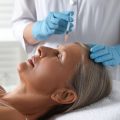Understanding Rosacea in the UK Context
Rosacea is a chronic skin condition characterised by facial redness, visible blood vessels, and sometimes small red bumps or pustules. While it affects people globally, living with rosacea in Britain comes with its own set of unique challenges. The unpredictable British climate—where you can experience all four seasons in a single day—plays a significant role in both triggering and worsening rosacea flare-ups. Sudden changes in temperature, dampness, brisk winds, and the occasional rare burst of sunshine can all have an impact on sensitive skin. For many Brits, simply stepping outside into the cool morning air or enduring a stuffy commute on the Tube can spark uncomfortable symptoms. Moreover, the high humidity levels typical of the UK, combined with persistent drizzle or abrupt cold snaps, create conditions where managing rosacea becomes not just about skincare routines but also about understanding and adapting to your local environment. Recognising how these distinctly British environmental factors interact with your skin is the first step towards finding real solutions that work here at home.
Common British Climate Triggers
Living in the UK, Ive come to realise that our ever-changing weather plays a big part in how my rosacea behaves. The typical British climate is notorious for its unpredictability—one moment its drizzling, the next a sharp wind cuts through your coat, and before you know it, the sun peeks out from behind the clouds. These rapid shifts can wreak havoc on sensitive skin, especially when youre prone to flare-ups like I am.
Let’s break down some of the most common climate triggers that affect those of us managing rosacea in Britain:
| Weather Element | How It Aggravates Rosacea |
|---|---|
| Dampness & Humidity | Excess moisture can make skin feel clammy and inflamed, leading to increased sensitivity and potential breakouts. |
| Brisk Winds | Chilly winds strip away natural oils, leaving skin dry, irritated, and more vulnerable to redness and stinging. |
| Fluctuating Temperatures | Going from cold outdoors to warm interiors (or vice versa) causes blood vessels to expand and contract rapidly, which often results in facial flushing. |
| Central Heating | The dry heat indoors saps moisture from the skin, intensifying tightness and discomfort—something I notice every winter. |
This combination of external forces creates a perfect storm for rosacea flare-ups. For me, it often means having to adapt my skincare routine several times a day: layering up with a scarf when stepping out into biting winds or using a humidifier at home when the heating is on full blast. Being aware of these triggers is the first step towards building resilience for your skin and finding some sense of comfort amidst the famously fickle British weather.
![]()
3. Adapting Your Skincare Routine
Living in the UK, we all know how the weather can shift from drizzly mornings to bursts of sunshine within a single afternoon. When you’re managing rosacea, these rapid changes can really take their toll on your skin. After years of trial and error, I’ve found that gentle tweaks to my daily routine made all the difference—especially when it comes to choosing products that suit our unique British climate.
Keep It Simple and Soothing
The first golden rule? Less is more. I always reach for a mild, fragrance-free cleanser like Cetaphil Gentle Skin Cleanser or the trusted Simple Kind to Skin range, both readily available in Boots and Superdrug. These don’t strip your skin or leave it feeling tight after a blustery walk along the Thames or a day battling city pollution.
Moisture That Matches Our Weather
Humidity and cold winds can both aggravate rosacea, so locking in moisture is key. Lightweight creams with ceramides or hyaluronic acid, such as CeraVe Moisturising Cream or E45 Cream, offer protection without clogging pores. I apply mine while my face is still slightly damp after cleansing—a tip picked up from local dermatologists—to help seal in hydration.
Sun Protection: A Year-Round Must
Don’t be fooled by grey skies! UV rays penetrate clouds and can trigger flare-ups even on overcast days. I opt for a broad-spectrum SPF 30+ sunscreen formulated for sensitive skin—La Roche-Posay Anthelios is a British favourite. Dabbing it on gently every morning has become as routine as popping the kettle on for a cuppa.
Practical Application Tips
If my cheeks are feeling particularly tender (often after a sharp north wind), I use clean fingertips to softly press rather than rub products into my skin—think of it as giving your face a little hug. And when switching between central heating indoors and chilly commutes outside, I carry a mini mist of thermal spring water (like Avène’s) for an instant calming spritz on the go.
By tailoring your skincare steps to our ever-changing British weather—and choosing gentle, locally-loved products—you can help your complexion stay calm, comforted, and beautifully resilient through every season.
4. Day-to-Day Lifestyle Tweaks
Living in Britain, where the weather can switch from drizzle to sunshine in a matter of hours, means our daily routines need to be adaptable—especially when managing rosacea. From my own experience, subtle tweaks can make all the difference in keeping flare-ups at bay. Here are some practical tips that blend seamlessly into British life, offering comfort and style without compromising your skin’s wellbeing.
Choose Fabrics Wisely for Layering
Layering is a quintessentially British way to dress for unpredictable weather. However, not all fabrics are created equal when you have sensitive, rosacea-prone skin. I’ve found that natural fibres like cotton and bamboo are far gentler than synthetics or wool. They breathe well and help regulate body temperature, minimising irritation from overheating or sweating on those rare warm days.
| Fabric Type | Best For | Avoid If |
|---|---|---|
| Cotton | Everyday layering; soft against skin | You need moisture-wicking for intense activity |
| Bamboo | Sensitive skin; antibacterial properties | You prefer crisp textures over softness |
| Merino Wool (fine gauge) | Chilly days; natural temperature control | You’re highly sensitive to wool fibres |
| Synthetics (polyester, nylon) | Quick-dry situations only | Your skin reacts to heat and sweat build-up |
Adapt Your Diet the British Way
Traditional British fare doesn’t have to be off-limits if you’re mindful of common rosacea triggers like spicy foods, alcohol, and very hot drinks. Through trial and error, I discovered that swapping my piping-hot morning tea for a warm (not scalding) brew made a difference. Similarly, choosing milder versions of classic favourites—think shepherd’s pie with extra veg instead of heavy gravy dishes—can be kinder to your complexion.
Simple Dietary Swaps for Rosacea-Friendly British Meals:
- Tea Time: Let tea cool slightly before sipping; opt for herbal blends like chamomile or peppermint.
- Pubs & Pints: Choose lighter beers or mocktails over strong spirits; enjoy with food to buffer potential triggers.
- Sunday Roast: Go heavy on steamed veggies and potatoes; use minimal spices and avoid very hot sauces.
- Breakfast: Swap fried options for poached eggs and wholemeal toast; add fresh fruit for an antioxidant boost.
The Little Extras That Matter
I always carry a mini facial mist with thermal spring water—perfect for soothing sudden flushes when dashing between meetings or errands in the city. Keeping a scarf handy (in soft, non-irritating material) also lets you shield your face from biting wind without trapping too much heat. Small changes like these fit effortlessly into everyday routines and help keep your confidence high as you navigate both the climate and your skin’s moods.
5. Finding Calm: Mindful Management
Living with rosacea in the UK can feel overwhelming at times, especially when flare-ups seem to strike just as you’re heading out for a Sunday roast or meeting friends for a cuppa. Over the years, I’ve learned that managing my skin is as much about mental well-being as it is about topical treatments. One of the most comforting discoveries was how supportive the British community can be—there’s something beautifully reassuring about knowing you’re not navigating this journey alone.
Embracing Mindfulness and Self-Compassion
I often start my mornings with a few mindful minutes, simply breathing and acknowledging whatever emotions might be swirling around. The unpredictable British weather can sometimes heighten my anxiety about my skin, but gentle practices like mindfulness meditation or even a quiet stroll through my local park help me find perspective. It’s not just about calming the mind; it’s about creating a little space for self-compassion, especially on days when my cheeks are flushed and sensitive.
Reaching Out: Community Support
I remember one particularly challenging winter when my rosacea was at its worst. It was only after attending a local support group in London that I realised how many others were facing similar struggles. Sharing tips over a pot of Earl Grey and swapping stories made me feel less isolated. If you’re based outside major cities, online forums—like those hosted by the British Skin Foundation—offer a welcoming space to connect, ask questions, and receive encouragement from people who truly understand what you’re going through.
Expert Guidance: Local Skincare Specialists
Don’t underestimate the value of seeking professional advice. My first visit to a British skincare specialist was transformative; they offered tailored recommendations that actually worked in our damp, changeable climate. Many chemists and clinics across the UK provide consultations—sometimes even free of charge—and their knowledge of locally available products can make all the difference. There’s no shame in reaching out for help; it’s often the most empowering step towards finding your calm amid the chaos of flare-ups.
If there’s one thing I’ve learned, it’s that managing rosacea isn’t just about what you put on your skin—it’s also about nurturing your inner resilience and drawing strength from the communities around you. Whether it’s sharing laughs at a support group or discovering new relaxation techniques in your own living room, every step towards mindfulness brings genuine relief in our ever-changing British climate.
6. Navigating Public Life with Confidence
Living with rosacea in the UK presents unique challenges, especially when it comes to social situations so quintessentially British—think popping down to the local pub, mingling at the office, or enjoying an afternoon at an outdoor festival. Each scenario can trigger anxiety about flare-ups or self-consciousness about visible redness. However, with a bit of planning and self-compassion, you can participate fully in public life while managing your skin condition with poise.
Pubs and Social Gatherings: Cheers Without Fear
The British pub is more than just a place for drinks—its a hub for social connection. If alcohol or spicy foods are known triggers for your rosacea, consider non-alcoholic alternatives that are increasingly popular across the UK, such as botanical spirits or alcohol-free ales. Don’t hesitate to ask bar staff for recommendations; there’s no shame in prioritising your wellbeing. For those moments when a sudden flush appears, keep a lightweight scarf handy—not only does it serve as a stylish accessory, but it also offers gentle coverage without drawing attention.
Thriving at Work: The Office Environment
Open-plan offices and frequent meetings can sometimes amplify insecurities about rosacea flare-ups. Establishing a simple skincare routine that keeps your skin calm throughout the day is invaluable—opt for fragrance-free moisturisers and keep blotting papers or mineral powder at your desk for quick touch-ups. If you feel comfortable, have an honest conversation with close colleagues; British workplaces are increasingly aware of invisible health issues and often respond with empathy and support. Remember, professionalism isn’t defined by perfect skin but by your abilities and attitude.
Outdoor Events: Embracing British Weather
From Wimbledon to village fêtes, outdoor events are central to British culture—and so is unpredictable weather. UV exposure is a well-known rosacea trigger, even on overcast days. Carry a pocket-sized broad-spectrum SPF and a wide-brimmed hat (which doubles as a chic fashion statement). Layering lightweight clothing can help you adapt quickly if temperatures shift—a common occurrence in the British Isles! Most importantly, let yourself enjoy these gatherings; confidence often grows when you focus less on your appearance and more on the experience itself.
Ultimately, navigating public life with rosacea in Britain is about embracing practical strategies while cultivating self-assurance. By preparing for common social scenarios and owning your unique beauty, you’ll discover that confidence can shine brighter than any flare-up.


